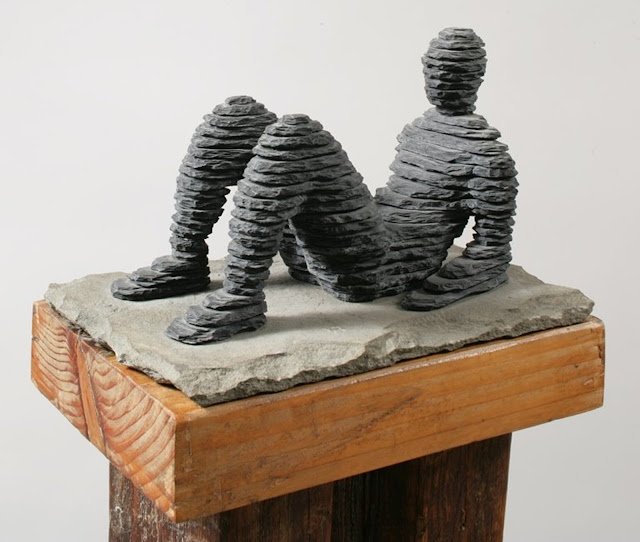Boaz Vaadia (November 13, 1951 – February 25, 2017) was an Israeli-American artist and sculptor who worked primarily in stone and subsequently by casting in bronze. Based in New York City since 1975, his studio is located in Brooklyn. The power of natural materials and the relation of human beings to that power determine the content of Vaadia's sculpture. Vaadia said of his work, "I work with nature as an equal partner. The strongest thing I address is that primal connection of man to earth. It's in the materials I use, the environments I make, and the way I work.
Beginning in 1985, Vaadia turned his efforts toward figurative motifs executed solely in stone. Retained from previous efforts was the utilization of gravity as a force in maintaining stability. For these body-based forms, his methodology entailed stacking gradated rock sheets in a formation suggestive of individual stones modified by chisel-marked surfaces.Vaadia says, "It was quite an exciting moment for me when I realized that I actually could go back to figurative work and still have the respect for the way the bluestone and slate are formed in nature…" By chipping away unwanted rock, Vaadia took advantage of the way nature layers sediment. Using traditional tools - hammer and chisel - he molded each single stone to suit the whole composition. As a result, this work reflects sculptural techniques which parallel natural transformations in stone. The artist's stratification of stones echoes natural conversions of matter.This development within his work opened up a long period of great creative output and recognition. Vaadia understood that his chosen materials limited what could be built with them, and by respecting the structural properties of bluestone slabs, he created an artistic restriction for himself: each one of his sculptures must be able to stand and to hold together bound only by the force of gravity (though ultimately bolted together for safety and permanency). As a result, he has knowingly limited himself to stable, compact poses, and a generalized human form that alludes to Easter Island moai, Egyptian Pharonic sculpture, and Buddhist repose.Wikipedia
Beginning in 1985, Vaadia turned his efforts toward figurative motifs executed solely in stone. Retained from previous efforts was the utilization of gravity as a force in maintaining stability. For these body-based forms, his methodology entailed stacking gradated rock sheets in a formation suggestive of individual stones modified by chisel-marked surfaces.Vaadia says, "It was quite an exciting moment for me when I realized that I actually could go back to figurative work and still have the respect for the way the bluestone and slate are formed in nature…" By chipping away unwanted rock, Vaadia took advantage of the way nature layers sediment. Using traditional tools - hammer and chisel - he molded each single stone to suit the whole composition. As a result, this work reflects sculptural techniques which parallel natural transformations in stone. The artist's stratification of stones echoes natural conversions of matter.This development within his work opened up a long period of great creative output and recognition. Vaadia understood that his chosen materials limited what could be built with them, and by respecting the structural properties of bluestone slabs, he created an artistic restriction for himself: each one of his sculptures must be able to stand and to hold together bound only by the force of gravity (though ultimately bolted together for safety and permanency). As a result, he has knowingly limited himself to stable, compact poses, and a generalized human form that alludes to Easter Island moai, Egyptian Pharonic sculpture, and Buddhist repose.Wikipedia















No comments:
Post a Comment